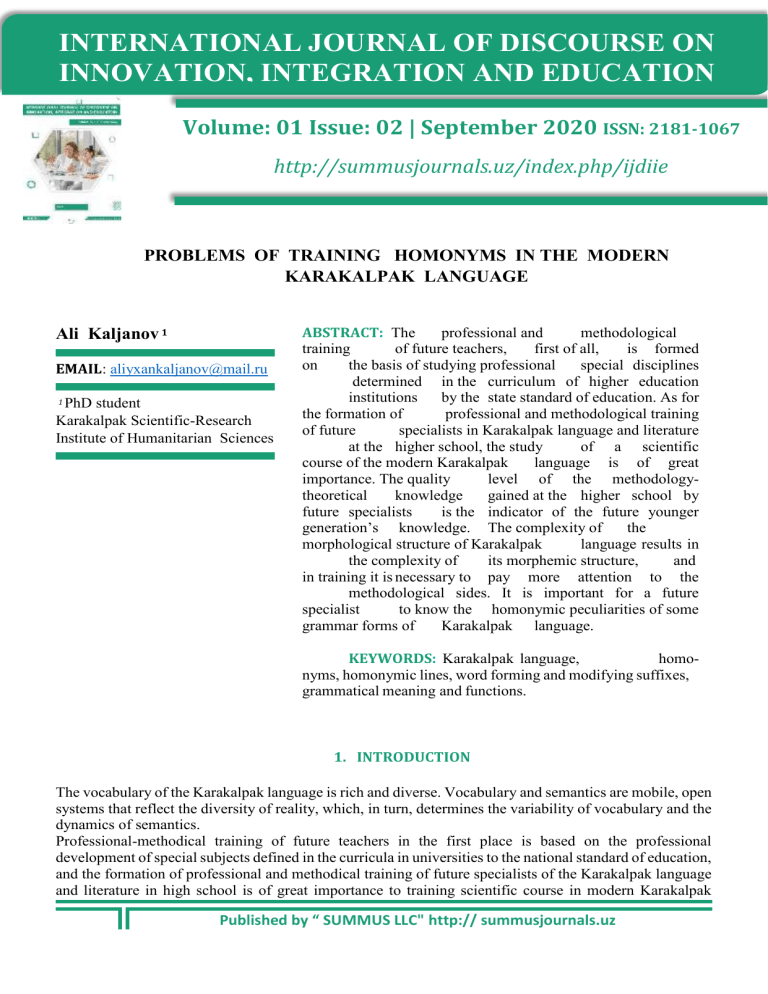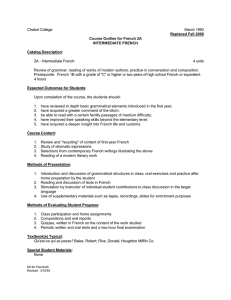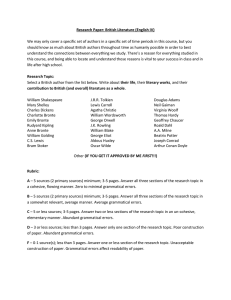
INTERNATIONAL JOURNAL OF DISCOURSE ON INNOVATION, INTEGRATION AND EDUCATION Volume: 01 Issue: 02 | September 2020 ISSN: 2181-1067 http://summusjournals.uz/index.php/ijdiie PROBLEMS OF TRAINING HOMONYMS IN THE MODERN KARAKALPAK LANGUAGE Ali Kaljanov 1 EMAIL: aliyxankaljanov@mail.ru 1 PhD student Karakalpak Scientific-Research Institute of Humanitarian Sciences ABSTRACT: The professional and methodological training of future teachers, first of all, is formed on the basis of studying professional special disciplines determined in the curriculum of higher education institutions by the state standard of education. As for the formation of professional and methodological training of future specialists in Karakalpak language and literature at the higher school, the study of a scientific course of the modern Karakalpak language is of great importance. The quality level of the methodologytheoretical knowledge gained at the higher school by future specialists is the indicator of the future younger generation’s knowledge. The complexity of the morphological structure of Karakalpak language results in the complexity of its morphemic structure, and in training it is necessary to pay more attention to the methodological sides. It is important for a future specialist to know the homonymic peculiarities of some grammar forms of Karakalpak language. KEYWORDS: Karakalpak language, homonyms, homonymic lines, word forming and modifying suffixes, grammatical meaning and functions. 1. INTRODUCTION The vocabulary of the Karakalpak language is rich and diverse. Vocabulary and semantics are mobile, open systems that reflect the diversity of reality, which, in turn, determines the variability of vocabulary and the dynamics of semantics. Professional-methodical training of future teachers in the first place is based on the professional development of special subjects defined in the curricula in universities to the national standard of education, and the formation of professional and methodical training of future specialists of the Karakalpak language and literature in high school is of great importance to training scientific course in modern Karakalpak Published by “ SUMMUS LLC" http:// summusjournals.uz IJDIIE Volume: 01 Issue: 01 | August 2020 language. The quality of the level of methodological and theoretical knowledge accumulated in higher education by future specialists is an indicator of the knowledge of the future young generation. The complexity of the morphological structure of the Karakalpak language leads to the complexity of its morphemic structure, and there is a need to pay more attention to the methodological aspects of teaching. To be precise, word endings that modify the form of a word among themselves, as well as with wordforming endings, make up a homonymic series, which requires teachers to attach more importance to the morphological structure of the language in teaching. Therefore, it is important for a future specialist of the Karakalpak language to know the homonymic features of some grammatical forms. 2. THEORITICAL BACKGROUND The abundance of grammatical units in morphology increases the number of morphemes in the word, and the complication of the word composition, their similarity to other units of the language, the complexity of the problem of teaching morphology proves the need to increase the responsibility of the teacher in the course of his training, since units in morphology are found in other sections of linguistics. Thus, these issues require future specialists to have perfect knowledge of the section of linguistics-morphology. In word-forming and form-forming endings, a homonymic series is developed, and therefore it is important to know the features of their differences. They are layered on top of each other as part of words in sentences. The study takes into account the fact that grammatical homonyms are taken as the main lexical-grammatical and paradigmatic basis of morphology. The main criterion in distinguishing grammatical homonyms is the identification of grammatical meaning and their functioning – the main principle of the research methodology. The main conclusion of the works identified in the course of the study is a comparison, analysis, generalization, presentation, systematization of the actual problem. In general, the morphological structure of the Karakalpak language is very complex since, as is known, the Karakalpak language, like all Turkic languages, is rich in word-modifying suffixes and belongs to agglutinative languages, and agglutinativity involves attaching several endings to the base of a word, focusing in one place. This pattern causes some difficulties in studying the morphemic structure of the word. 3. MAIN PART Word-forming suffixes and form-forming endings have very strong homonymic qualities. To distinguish them, you need to know the features of inflectional suffixes. In addition, both word-forming suffixes and form-forming suffixes in the words are layered on top of each other, and the study of grammatical homonyms is based on lexical-grammatical and paradigmatic principles. Grammatical homonyms – words that have endings by the forms sound the same, but they have different grammatical meanings attached to the word. The main criterion for distinguishing grammatical homonyms of endings is the grammatical meaning and their functioning. A grammatical value is a value formed based on the relationship of a word with other words in a sentence, that is, as a result of conversion. One type of grammatical meaning is categorical grammatical meaning. A categorical grammatical value is formed by attaching various grammatical values to the word a morpheme to a word and forms a grammatical form corresponding to a particular part of speech. Grammatical forms of words develop and are formed in accordance with the internal laws of language development. The grammatical form of a word and its grammatical meaning are closely related and are a single phenomenon." Therefore, where there is a grammatical form, there is also a grammatical meaning. Any grammatical form has a categorical grammatical meaning, so the student must learn to determine the grammatical meaning of homonymous grammatical forms layered on the root. Published by “ INTER SCIENCE" http://ihm.iscience.uz/index.php/ijihm IJDIIE Volume: 01 Issue: 01 | August 2020 When studying homonymous suffixes, special attention should be paid to the grammatical meaning and grammatical function of each ending. However, when studying grammatical homonyms of the Karakalpak language and differentiating them from each other, the analysis is most effective in the following order: 1) search for uniform suffixes; 2) determining grammatical meaning; a) statement of the question; b) search for signs that allow you to separate the general grammatical meaning from the lexical one; 3) defining part of speech: a) search for paradigmatic features; b) define a grammatical category; 4) defining a syntactic function in a sentence. Homonyms belong to the central lexicological topics in the study of the Karakalpak language. They contribute to the deepening and generalization of important lexicological and stylistic knowledge, contribute to the development of language flair. In the process of learning homonyms: a) learners 'theoretical knowledge of the lexical structure of the Karakalpak language is formed; b) learners' knowledge of the functional and stylistic capabilities of the studied language units is enriched; c) the individual's communicative activity is developed' d) develop practical skills and the ability to use homonymic language units in speech in accordance with the situation of communication; e) increase the level of general culture of learners. By assimilating homonyms of the Karakalpak language, learners gain knowledge about the surrounding reality and enrich their picture of the world. We consider it necessary to use the table to show the root and the homonymous zero form, each has a different grammatical meaning to make sure that the grammatical meaning is different, learners should pay attention to the grammatical meaning, question, part of speech, grammatical category. 4. CONCLUSION In general, creating a homonymic series of suffixes is difficult both when teaching the Karakalpak language and when studying it. The main indicator for a correct understanding of grammatical homonymy is its grammatical meaning and functions. From the point of view of this question, the grammatical homonyms of the Karakalpak language are defined, a systematic comparison is made for their correct understanding, and their meanings and functions are revealed. Grammatical analysis also helped to reveal the features of grammatical homonyms of the language and correct their development. Professional orientation is also important in the learning process. In this direction, when training specialists in pedagogical universities, one of the methods of training in conjunction with the future specialty is teaching effective methods of working with school textbooks, which is important for improving professional and methodological knowledge. In conclusion, we would like to note that when teaching homonyms of the Karakalpak language in the educational process, it is of particular importance to correctly master them and correctly understand the structure of the language. Since homonyms are a language phenomenon with a high frequency of use in the language. REFERENCES Baltabaeva Zh, Suleymenova Zh.N. Problems of training grammatical homonyms. International journal of applied and fundamental research. № 5, 2019 p 98-102 Kuleshova R. V. Teaching Russian homonyms to foreign students of philology in the framework of a special course. Fundamental study, №10, 2007. Published by “ INTER SCIENCE" http://ihm.iscience.uz/index.php/ijihm IJDIIE Volume: 01 Issue: 01 | August 2020 Ali Kaljanov. Question of homonyms in teaching language. Collection of articles and conference materials on “The importance of using innovative methods in teaching foreign languages and translation problems”. Fergana. 2020, p 61-62. ugli Khurramov, A. M. (2020). The role and role of digital economy and information technology in the agricultural sector. International Journal on Integrated Education, 3(2), 42-44. DOI: https://10.31149/ijie.v3i2.10 2. Ablaqulovich, I. G., Salaxuddinovna, K. Z., Uytalovich, N. U., & Matlubovich, T. O. (2020). THE IMPACT OF THE ORGANIZATION OF A COTTON-TEXTILE CLUSTER ON THE SOCIOECONOMIC DEVELOPMENT OF THE REGIONS. International Engineering Journal For Research & Development, 5(4), 5-5. DOI: https://10.17605/OSF.IO/2ZR8E 3. Khurramov, A. (2020). DIGITAL ECONOMY-A NEW ERA OF DEVELOPMENT. Студенческий вестник, (12-5), 53-54. 4. Ilkhomovich, S. E. (2020). The development of electronic trade and its role in general trade activities. ACADEMICIA: An International Multidisciplinary Research Journal, 10(3), 128-132. DOI: https://10.5958/2249-7137.2020.00060.9 Published by “ INTER SCIENCE" http://ihm.iscience.uz/index.php/ijihm



